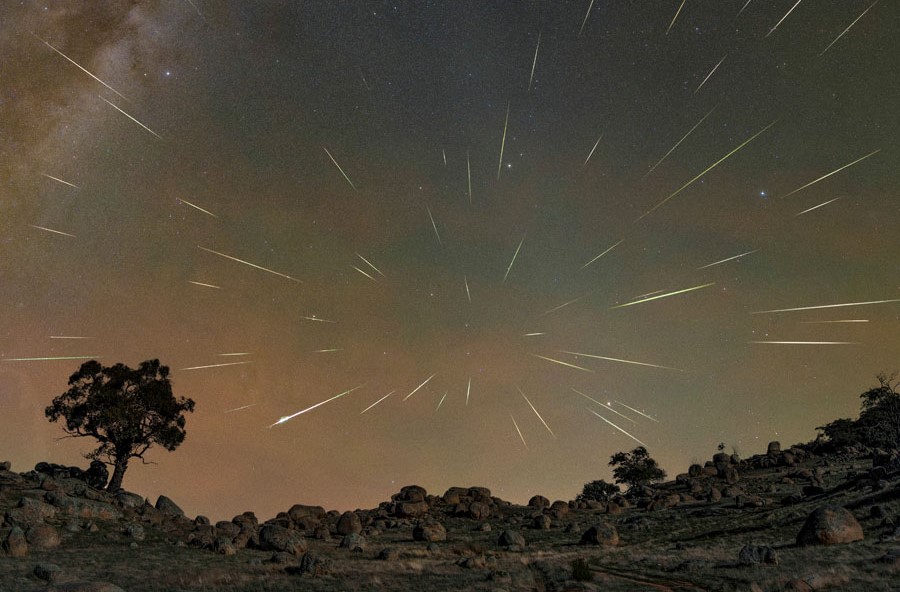Eliot Herman
If you’re willing to wake up with the birds you’re in for a treat starting this weekend. The Eta Aquariid meteor shower reaches maximum around 21 UT on May 5th, which means that the wee hours of both May 5th and 6th should provide equally good opportunities for meteor-watching. Under ideal conditions up to 50 meteors an hour can streak past, making it one of the strongest showers of the year. How many flaring motes of comet dust you actually see depends on two key variables (besides clear skies) — whether the Moon is present and the altitude of the radiant, the location in the sky from which the meteors appear to stream.

Stellarium
Not to worry about the Moon. It will be a thin crescent and arrive like a delicious appetizer on the tablecloth of dawn. The bigger issue is altitude. From Champaign, Illinois (latitude 40° north), the radiant hovers just 5° high in the southeastern sky at 3 a.m. local time, just an hour before the start of astronomical twilight. Add in a half-hour of minor, early-dawn illumination and the total viewing time comes only comes to around 90 minutes. Farther north, where the radiant sits even lower and twilight begins sooner, meteor-gazing contracts to around 75 minutes.

Stellarium
From the Southern Hemisphere it’s a different story. In Sydney, Australia, the radiant reaches an altitude of more than 40° by the start of morning astronomical twilight for a viewing window of more than three hours. The higher altitude of the radiant also means the horizon cuts off fewer meteors from view. That makes the Eta Aquariids one the best showers of the year — despite the late hour — for observers at tropical and southern latitudes. Curiously, the other strong shower in the nether hemisphere also originates in Aquarius — the Delta Aquariids, which peak around July 31st.

Rusty McGrath
Meteoric fame
Northerners reading this might think I’m subtly suggesting to sleep in and let this one pass. Nothing could be further from the truth. There are three good reasons to set that alarm. First, the shower’s dusty parent is Halley’s Comet, the most famous of them all. Each sand-sized grain shed by the 11-kilometer-wide island of dirty ice bears the famous English polymath’s imprimatur.
While many of us will never see the comet again in our lifetime, witnessing its powdery progeny flare to life just 100 kilometers overhead keeps it fresh in our memories. Many of us fondly recall Halley’s 1985–86 return, when we eagerly anticipated every clear night to get one last look at the once-in-a-lifetime visitor before it departed on its trans-Neptunian odyssey. Thanks to the Eta Aquariid shower and its sibling, the Orionids, Halley’s Comet keeps on giving.
Need for speed
Shower members strike the atmosphere at around 148,000 miles per hour (66 km/s), nearly as fast as the November Leonids, the swiftest of them all. As a rule, Etas don’t leave lingering trains — trails of ionized gas or glowing meteor dust — but their speed will take your breath away. The third reason to watch is to experience something surprising. Just putting yourself there at 3 or 4 a.m. almost guarantees seeing something unexpected. Given the dearth of evening planets it will be heartening to catch sight again of Mars and Saturn joined by the Moon in early morning twilight. Northern Hemisphere skywatchers will see the trio best on May 5th, while those in the Southern Hemisphere are favored on May 6th — with an extra dash of spice from Mercury!

Bob King
Given the radiant’s low slant find a location with an unobstructed view. Ideal spots include a lake shore, hilltop, or field. I typically watch from a reclining chair from my front yard which has a good view to the east and south. With the chair tipped about two-thirds back I get a generous face full of sky fringed by poplar and spruce trees in my peripheral vision. Wherever you choose to recline, look 90° to either side of the radiant for a pleasing mix of both short-trailed meteors (from the radiant direction) and longer-trailed ones that peel off to the sides. With the radiant in the southeastern sky (Northern Hemisphere), southwest and northeast are good directions to face. For the Southern Hemisphere, try northwest or southeast.

Peter Jenniskens and Ian Webster, meteorshowers.org
Each orbit Halley’s Comet lays down another strand of debris along its path, a portion of which is destined to light up as future Eta Aquariids. This year Earth brushes up against a filament deposited in 985 BC. Russian meteor shower expert Mikhail Maslov’s calculations indicate a possible uptick in meteor numbers from the encounter on May 3rd between midnight and 3 a.m. CDT.
Why wait for Halley’s Comet to return in 2061 when you can get in on the action right now? Go to bed early the night before and you’ll be no worse for the wear.


